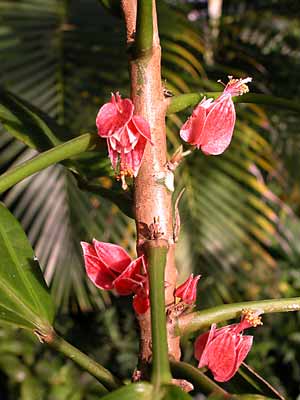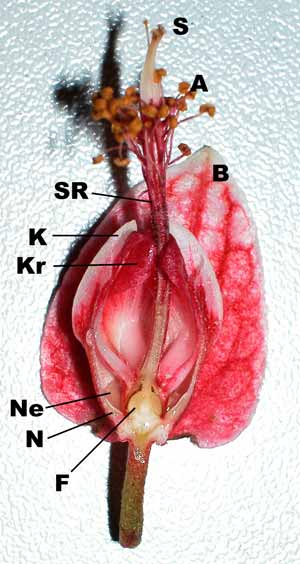
Malvaceae - Malvengewächse
Heimat: Brasilien.
Goethea cauliflora wächst als kleiner Baum oder Strauch im Unterwuchs tropischer Regenwälder Brasiliens. Eigenartig ist die Stammblütigkeit (Cauliflorie), d.h. die Blüten scheinen dem Stamm zu entspringen. Tatsächlich sitzen die Blüten aber an Kurztrieben, ähnlich wie die Kirsch- oder Apfelblüten am Fruchtholz sitzen. Als erstes sichtbar sind die 4 leuchtend rot-weiss gefärbten Hochblätter (siehe unten).
Die Pflanze ist vom deutschen Botaniker Nees von Esenbeck nach J. W. v. Goethe benannt worden. Gesammelt wurde die Pflanze zwischen 1815 und 1817 auf einer Südamerikareise des Prinzen von Neuwied, an der der bedeutende Südamerikaforscher Martius teilnahm.

S - Stigma (Narbe),
A - Antheren (Staubbeutel),
B - Hochblatt (Bractee, 3 dieser Blätter wurden entfernt),
SR - Staubfadenröhre aus den verwachsenen Staubfäden, die den im unteren Teil der Röhre weißlich sichtbaren Griffel umgeben. Die staubfäden sind basal mit den Kronblättern verwachsen.
K - verwachsenblättriger Kelch aus 5 Kelchblättern,
Kr - Krone,
Ne - klebrig süßer Nektar,
N - Nektarium an der Basis der Kelchblätter,
F - der fünfzählige Fruchtknoten. Darunter der hell gefärbte Blütenboden mit großen Schleimkanälen. Die Blüten werden sicherlich von Tieren mit einem langen Rüssel oder Schnabel beim Saugen des Nektars bestäubt
Zu sehen im Großen Tropenhaus. (03.01.2004, M.H.H.)